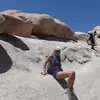Snake
It's unlikely that you'll come across a snake in the middle of a trail, because they often stay away from noise or rustling, which your walking causes. Therefore, your first step in wild animal safety for snakes is to be aware. However, if a snake is slithering across the trail in front of you, stop moving: this may be perceived as a threat. If it's sitting still, or makes it to the other side of the trail, walk around it or walk away from it slowly. Do not make the snake feel cornered or threatened, this may cause it to attack.
More: Hiking With Your Dog: Rattlesnake 101
Cougars
If you see a cougar, don't run. You'll want to pick up small children as cougars are more apt to go after smaller prey. Make yourself as big as possible. If the cougar remains still, make eye contact and back away slowly. Never play dead if attacked, defend yourself as best you can, covering your throat and head.
Coyote
Coyotes are more likely to appear at dusk, so it's best to avoid trails and dark places at that time. If you come upon a coyote, do not approach it. Indications that it's ready to charge include long barking, following you, or rearing its hind legs. If you feel threatened, throw stones in its direction—not at it—as a scare tactic. Clap loudly, and yell, trying to be as loud as you can.
Raccoon
If you see a raccoon, assess its behavior. If it's overly aggressive or incredibly tame, this could indicate that it's sick or disoriented. Scare all raccoons away by making loud noises, throwing stones, or spraying water.
More: How to Avoid Critters While Camping
Wolf
Wolves are the least aggressive of the animals on this list, and wolf attacks are the rarest of all large predators. If you see a wolf or pack of wolves, slowly back away, maintaining eye contact. Always make yourself bigger by raising your arms, opening your jacket and standing tall. Be loud, making as much noise as possible.
Moose
With a top speed of more than 30 mph, you will not outrun a moose. However, contrary to most wild animal safety tips, running is your best defense against a moose attack. You'll want to run for cover or a tree you can climb. If you're knocked down, immediately cover your head as best you can; curl into a ball and wait until the moose leaves and is out of site. Only then should you get to your feet.
More: Seven W's of Hiking Safety: Wildlife
 Book your next camping trip
Book your next camping trip



